In the first of a six-part series to assess on-ground protests against the Bullet Train project, mid-day travels to a village in Gujarat to meet adivasis who may lose their ancestral land

Dungra resident Tanoj Kumar with his family at his home. Pics/ Sneha Kharabe
 Tanoj Kumar remembers the morning two years ago when he woke up to find a foot-high cylindrical concrete structure outside his 25-year-old home. Around 100 other homes in the 400-year-old Dungra village —about eight kilomteres from Vapi in Gujarat — woke up to the same inexplicable sight. It was the first time the village learnt about the government's ambitious Bullet Train project and that their homes lay in its path.
Tanoj Kumar remembers the morning two years ago when he woke up to find a foot-high cylindrical concrete structure outside his 25-year-old home. Around 100 other homes in the 400-year-old Dungra village —about eight kilomteres from Vapi in Gujarat — woke up to the same inexplicable sight. It was the first time the village learnt about the government's ambitious Bullet Train project and that their homes lay in its path.
At first though, the villagers, mostly adivasis, had little clue what the blocks, placed overnight in their village, each with a number, meant. A few days later, says 32-year-old Kumar, when we meet him at his verandah where he is sitting with his two-year-old daughter, a few officials came to the village. "We don't know who they were or which government agency they were from. They neither showed us any ID nor were they accompanied by any local government official that we were familiar with," he adds. "All that they told us was that our village lies in the path of the Bullet train and it—or at least parts of it, and especially the homes with the cement structure in front of them—would be demolished to make way for the train," says Kumar who works at a private firm in Vapi.
The Bullet dream
The high-speed rail corridor, set to connect Mumbai and Ahmedabad by 2023, has been touted as Prime Minister Narendra Modi's pet project. However, in May 2013, the then Prime Minister Manmohan Singh had announced the launch of the project in India. Following this, in September 2013, India and the Japanese government signed a memorandum of understanding (MoU), under the UPA regime, to undertake a joint feasibility study of the route. The two prime ministers decided that the two sides would co-finance this study for the Delhi to Mumbai route. The objective of the study was to prepare a feasibility report of the train that would run at a speed of 160 to 200 km/hour. Eventually, the two PMs welcomed the final report, and confirmed that further consultation between the two countries would be continued to draw up a road-map.
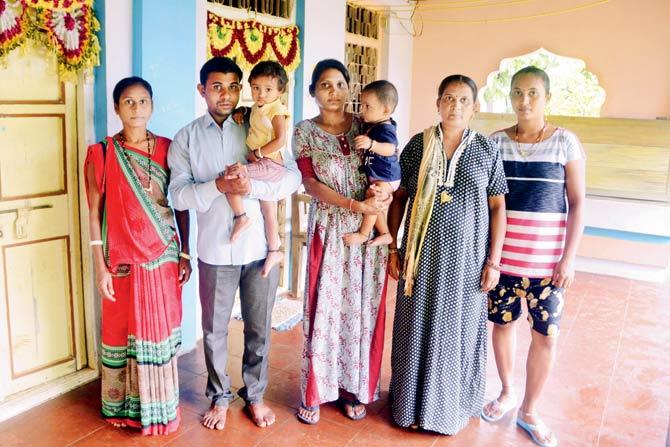 Dungra resident Tanoj Kumar with his family at his home
Dungra resident Tanoj Kumar with his family at his home
In 2014, however, when the NDA government came to power, PM Modi announced that this was his dream project. It was then decided to run the high-speed train between Ahmedabad and Mumbai at a speed of 360 km/hr. While the initial deadline for this project was 2020, it has now become December 2023.
However, the project has now come under a cloud with nearly 40,000 trees marked to be felled from many forest areas for the project. These forests harbour not just trees, but also precious wildlife. And then there's the human cost. Besides Dungra, another 295 villages in Gujarat and Maharashtra are set to be affected to make way for the train, which is expected to ferry 17,900 passengers one way daily.
For Kumar, however, his introduction to the Bullet was a rude awakening.
"Some government officials trespassed on our property while we were asleep, and planted cement structures along with survey numbers outside every home. Our family of 12 members has no place to go," he says.
Suspicious and tight-lipped
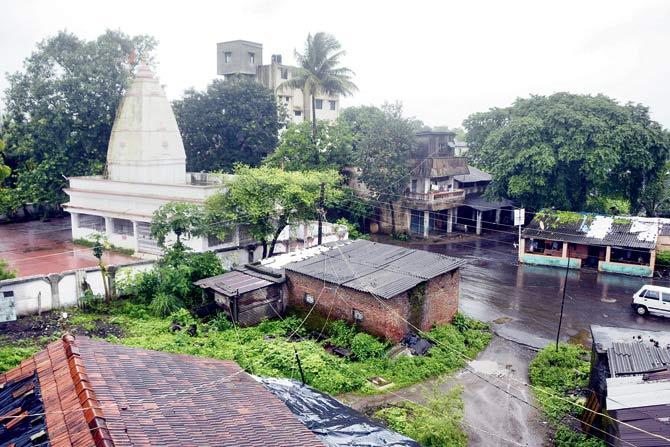 A 400-year-old Shiv temple lies at the centre of Dungra village
A 400-year-old Shiv temple lies at the centre of Dungra village
In August 2018, Arcadis India Private Limited prepared a Resettlement Action Plan for the National High Speed Rail Corporation Ltd (NHSRCL) authored by N K Singh, Lalita Pant Joshi, Dr Rajani Iyer, Rajneesh Kumar and reviewed and authorised by Mainak Hazra. The report states, "First stakeholder consultations were conducted at Tehsil/Taluka level involving government officials, Mamlatdar, village revenue officials (Talatis), village representatives of Panchayats and PAHs, PAPs and local communities in villages before initiating census and socio-economic survey to share project information, likely impacts, the importance of surveys, and to understand their perception, concerns, and issues. About 36 such consultations were held."
Certainly not in Dungra, or any of the other to-be affected villages that mid-day visited in Gujarat. mid-day tried reaching out to Arcadis officials, but they were unavailable for comment.
In Dungra, the residents are suspicious of every new person entering their village. Had it not been for a local activist (who prefers the safety of anonymity), Kumar wouldn't have spoken to us. They ask if we are from the government and visibly relax when we say no. "We are still visited by government officers now and then to survey the property," Kumar says. As per the Resettlement Action Plan, by now the government should have taken along local stakeholders such as Kumar to ensure a smooth alignment for the Bullet. But, with that allegedly not having happened almost everyone is in agreement with Kumar when he says, "Our ancestors left these homes to us, we won't budge."
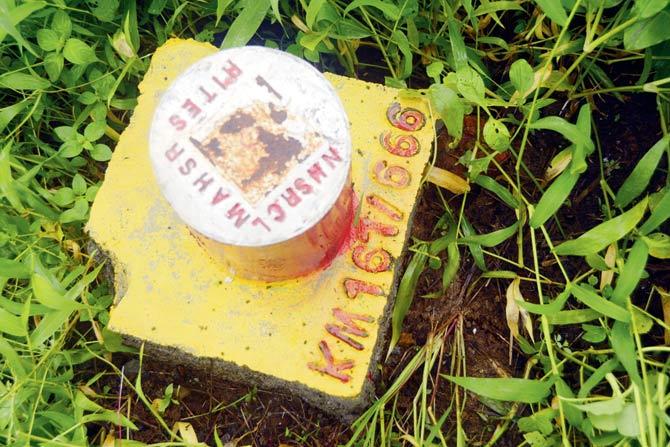
The cylindrical structure that local residents found outside their homes signifying that their house will be demolished to make way for the Bullet Train project
When we asked about the compensation rates to KJ Bhagora, the prant officer of Valsad under which Dungra village comes, he refused to comment saying, "I was recently transferred to another district and now DI Patel has taken charge as the new deputy collector of Valsad." Patel, on the other hand, was unavailable for a comment.
A celluloid revolution
With 296 villages and 1,434.28 hectares of land set to be lost, a documentary is making the rounds at the grassroots level, calling villagers to stand up and fight for their rights. Their right to say no to the Bullet and to ask for better compensation. Titled simply Bullet, the 58-minute-long film went online on July 13 this year. It's director, Dakxin Chhara, an Ahmedabad-based filmmaker, accompanied us to Dungra. The docu, he says, travels from Ahmedabad to Vapi, and investigates the land acquisition in both rural and urban areas of Gujarat. It follows members of the Gujarat Khedut Samaj— a non-profit organisation that fights for farmers' rights— as they create awareness across the eight Gujarat districts that will be affected through a protest rally.
In fact, it was Khedut Samaj that approached Chhara to document their five-day-long Kisan Sampark Yatra last year. "Since I wasn't doing much then, I agreed to join the protest rally. I accompanied the NGO members for this yatra as a silent observer. I have documented the sentiments of these farmers. What I saw left me stunned; these people have no clue about their rights over their property," says Chhara.
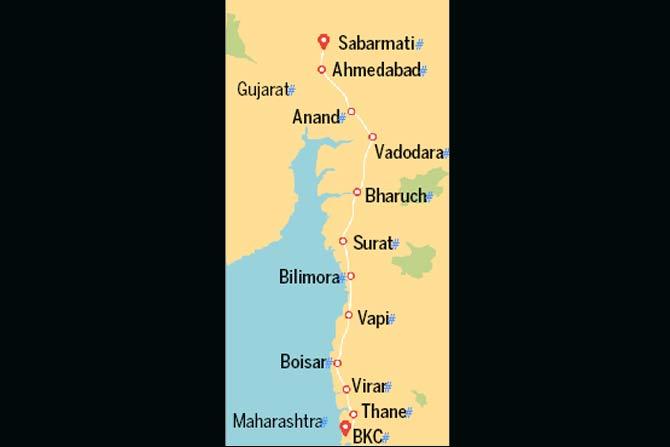 Maps/Uday Mohite
Maps/Uday Mohite
The reason Chhara is the perfect filmmaker to address the issue, says Jayesh Patel, president of Gujarat Khedut Samaj, is because "he understands what government's injustice can do to your life."
Chhara whose father wanted him to become an IAS officer, said, "Back in 2003, I would organise political plays in our village. I did my first play showcasing police atrocities on the Chhara community in 1998. I was simultaneously studying for IAS. I was to appear for the test on June 16 in 2003, but I, along with my father, was arrested on June 10 because my anti-police plays had started to draw attention in the state."
While the arrest put an end to his father's dream, Chhara started to pursue his own—cinema. "I have made some 96 documentaries so far; but Bullet is close to my heart."
For one man's dream
"When I was shooting the film, many farmers said they would die rather than letting the railway track pierce through their homes and farms. Some said he [PM Modi] is not eradicating poverty, but increasing it under the guise of this project. Others said Gujarat's poor will curse those behind this project," Chhara adds. After closely hearing the woes of these farmers, Chhara feels the project isn't worth it. "For one man's dream, thousands of people will have to pay a huge price."
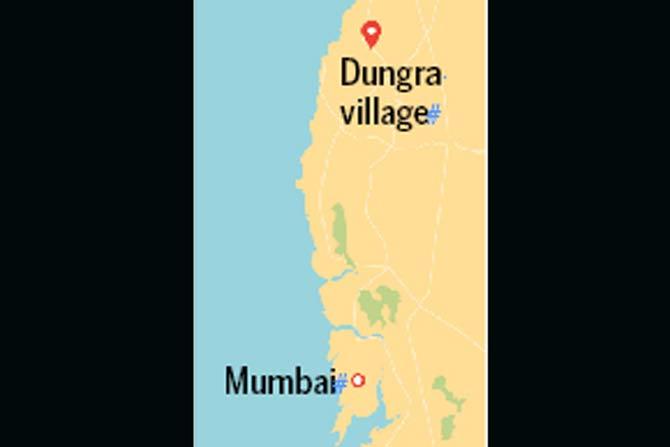
17,900
No. of passengers the Bullet is expected to ferry one way daily
2023
Year the project is supposed to be completed
Catch up on all the latest Mumbai news, crime news, current affairs, and also a complete guide on Mumbai from food to things to do and events across the city here. Also download the new mid-day Android and iOS apps to get latest updates
 Subscribe today by clicking the link and stay updated with the latest news!" Click here!
Subscribe today by clicking the link and stay updated with the latest news!" Click here!









